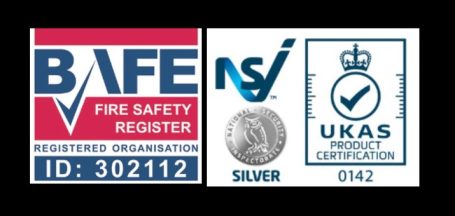Fire Risk Assessment Services
Your Trusted Partner in Fire Safety
A Fire Risk Assessment is a legal requirement for all non domestic premises in England and Wales. Every workplace requires a fire risk assessment by Law.
The Regulatory Reform (Fire Safety) Order 2005 is the legislation that you need to comply with, it is often referred to as the FSO. The FSO also covers the communal areas of blocks of flats, both sides of a flat entrance door and an appraisal of the external wall structure.
Recent legislation changes now include: The Fire Safety Act 2021. The Fire Safety (England) Regulations 2022. The Building Safety Act 2022.
Fire Risk Assessments
Fire Risk Consulting North provide fire risk assessments for all business types; from care homes, residential properties including HMO's and heritage buildings to food production factories offices and hair salons.
We prioritize your safety with our expert fire risk consultancy services. Our team is committed to delivering personalized fire safety solutions that not only meet but exceed legal compliance standards. With extensive experience in fire protection services, we focus on continuous improvement, ensuring you receive the highest caliber of service.
What is a Fire Risk Assessment?
A fire risk assessment (FRA) is a methodical look at your business premise. What it is used for, the number of people who work in it, any hazards associated within the workplace, the ways of reducing, replacing or removing these hazards and the recording of hazards. An action plan is then created for you to utilise and put any additional fire safety measures in place, helping you meet with your legal obligations.
Who is responsible for making sure an FRA is carried out?
If you are in control of any premise, i.e. the owner or the managing agent or an occupier/tenant, or you employ people within a building then you are deemed to be the Responsible Person and you must ensure a fire risk assessment is carried out. You will also need to appoint someone within your organisation to assist you with the upkeep of all the fire safety preventative and protective measures within your building. Things like testing the fire alarm on a weekly basis, testing the emergency lighting on a monthly basis, ensuring they are maintained and records kept.
The Responsible Person must be considered competent and given the time and any required training to allow them to carry out the role thoroughly. The FSO defines a person being competent as someone who has sufficient training, experience or knowledge.
How often do I need to have a FRA carried out?
This is determined by the risk to people from fire and their ability to evacuate from the building quickly and safely if a fire was to occur. Factors taken in to account are: the type, size and use of the building, the number of people who work in it, do people sleep in the building i.e. is it hotel or guest accommodation? Whereby they will not be familiar with it, or its layout. Are large amounts of flammable or explosive substances used or stored in your workplace?
We will always put a timescale for review on your fire risk assessment. Typically, if a building is well managed and maintained, then every 12 months is considered to be acceptable. However only your individual fire risk assessment can ultimately determine this.
What if something changes in my business before the review is due?
You should constantly monitor your fire risk assessment to assess how effectively the risks in your building are being controlled. If you have any reason to suspect that your fire risk assessment is no longer valid, or there has been a significant change in your premises that has affected your fire safety precautions, then you will need to review and if necessary revise it. Reasons for review could include:
- Changes to work processes or the way that you organise them, including the introduction of new equipment
- Alterations to the building, including the internal layout
- Substantial changes to furniture and fixings
- The introduction change of use or increase in the storage of hazardous substances
- The failure of fire precautions, e.g. fire-detection systems and alarm systems, life safety sprinklers or ventilation systems
- Significant changes to displays or quantities of stock
- A significant increase in the number of people present; and the presence of people with some form of disability
- A fire has occurred
Fire Strategy
It is a legal requirement that fire safety information is provided by the Responsible Person following a new build, extension or refurbishment of a building. Regulation 38 of the Building Regulations 2010 for England is the legislation that needs to be complied with.
What is a fire strategy?
A fire strategy is the fire safety information for the building you occupy. For a simple building it could be a layout drawing of the building that displays the fire exit routes out of the building, where the fire compartment floors, walls, barriers and doors are, the location of the fire alarm system devices, emergency lights, fire extinguishers, fire escape signage, sprinkler systems, fire hydrants, high risk rooms/areas and any provisions for the evacuation of any disabled persons.
Do you have a building fire strategy?
You may occupy a building that isn't relatively new or has been modified or extended. Your fire risk assessment will identify any requirements.
Does your existing building fire strategy need reviewing?
You may have one, however it may no longer be relevant to your building and it's use. Your fire risk assessment will identify the need for this.


Fire Compartmentation
What is fire compartmentation?
Fire compartmentation is a fire safety feature that is designed into a building to stop the spread of smoke and fire, allowing people to escape safely from a building. It subdivides the building into fire compartments by means of fire separating walls, floors, doors, fire barriers and fire stopping to services that pass through walls and floors.
What is a fire compartmentation survey?
A fire compartmentation survey is a detailed visual inspection of the existing fire safety compartmentation features in place, including the floors, walls, floor and ceiling voids, basements, roof voids, service riser and any other shafts.
It is generally conducted when there is evidence or suspicion that the fire compartmentation features are not considered adequate or there is a lack of fire strategy information available.
©Copyright. All rights reserved.
We need your consent to load the translations
We use a third-party service to translate the website content that may collect data about your activity. Please review the details in the privacy policy and accept the service to view the translations.
